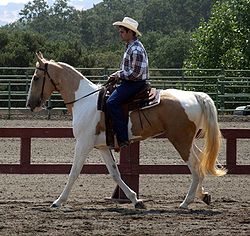 Spotted Saddle horses resemble Tennessee Walking Horses the most because of that breed's strong influence. Other breeds were introduced into the Spotted Saddle horse, including Standardbreds, Mustangs, Missouri Fox Trotters, Peruvian Pasos, Paso Finos, and Racking horses. Standardbreds contributed size, speed and lateral gaits. Mustangs added more color and hardiness. Missouri Fox Trotters and Racking Horses, which share a common ancestry with Walking Horses, have influenced type and gait. Even Peruvian Pasos and Paso Finos have contributed in recent years. Consequently, horses registered as "Spotted Saddle Horses" vary significantly from one another, both in body type and gait.
Spotted Saddle horses resemble Tennessee Walking Horses the most because of that breed's strong influence. Other breeds were introduced into the Spotted Saddle horse, including Standardbreds, Mustangs, Missouri Fox Trotters, Peruvian Pasos, Paso Finos, and Racking horses. Standardbreds contributed size, speed and lateral gaits. Mustangs added more color and hardiness. Missouri Fox Trotters and Racking Horses, which share a common ancestry with Walking Horses, have influenced type and gait. Even Peruvian Pasos and Paso Finos have contributed in recent years. Consequently, horses registered as "Spotted Saddle Horses" vary significantly from one another, both in body type and gait.
Most Spotted Saddle horses are about 15 hands high, though they can range from 13.3-16 hands high and weighing from 900 to 1100 pounds. A Spotted Saddle horse's head is of moderate length, refined, with a straight to slightly convex profile. The eyes are wide set, with a soft expression. Ears are moderately long, set well up on the head, and carried alertly. The neck is very slightly arched, muscular but trim, of moderate length, carried high, and with a good head carriage. The chest is of moderate width, and well muscled. Long, sloping hips and shoulders, common to smooth-gaited horses, are preferred, as is a fairly short back. The top line should appear shorter than the bottom line as this contributes to a long, smooth stride. The hindquarters are broad and well muscled.
Some lines reveal pony-type origins in a short-coupled, compact, sturdy body, with a somewhat coarse head and legs, while others exhibit more refined characteristics. Breed fanciers are split between the "true" old-type Spotted Saddle Horse, that generally didn't stand much over 14 hands versus a trend towards a Walking Horse build and gait. As a result, there are several different breed associations devoted to pinto-colored gaited horses, each with a slightly different slant.
